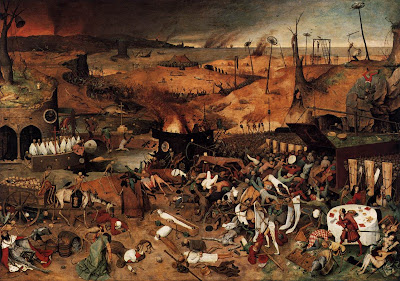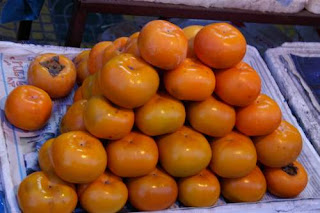 Hello again,
Hello again,
DISCLAIMER Lord love a duck, that horrific time absorber from HK is back online and clogging up bandwidth again. Sorry, I'm just built this way, apparently... DISCLAIMER END
So, this post is a bit unlike some of the previous posts; it is serious. Troy in Spain complained about a lack of substance to these posts (he apparently missed the rainpersimmon jam on my windows (see Update No. 5; now there was substance) so, today we delve into death. I mean, if I am going to be serious, I might as well head straight to a big issue like death.
(The cover piece, "The Triumph of Death" by Pieter Breugel the Elder is here simply because your Scribe loves it and a post on death is just too good an opportunity to skip for sharing this great painting (click here (and then click again on the image in the new site) to visit a site where you can see it in full screen-sized glory).)
So, back to Hong Kong.
Your heroine and your scribe found a great museum focused on death (or hope, depending on your perspective) a while ago. Your hero, Pommes, was feeling a bit under the weather and stayed home, but Regina and your scribe recently(ish) visited the Hong Kong Museum of Medical Sciences, tucked above and beside Soho in Hong Kong.
The museum is housed in an old medical laboratory and is quite nice, although the walls run with mould and algae in the building out back due to the rain, heat, and humidty.
Your heroine and your scribe had to wonder how many samples and analyses were contaminated by mould and algae in times past (Sorry Dr. Chin, the ingrown toenail biopsy came back... apparently the patient has a significant algae problem. We recommend two sucker fishes, leeches, and a good bleeding...), but that is not what was so interesting about this museum.
The Hong Kong Museum of Medical Sciences is located very close to where the community of Tai Ping Shan was before it (the community) was levelled physically and metaphysically.
In the 1890's 97% of Hong Kong was Chinese, and (so sayeth the museum) most lived in squalor in Tai Ping Shan; no electricity, no running water, no sanitation.
Well, that was common for much of the urban world of that time period, but Tai Ping Shan was very, very, tiny with a phenomenally high population density.
If you were (relatively) wealthy for a rather poor Chinese gentleman in 1894, you could buy a license to keep a pig in Tai Ping Shan, as an occupant of Tai Ping Shan yourself.
The only catch was that you could only keep the pig in your own flat or apartment. With a pig in the place, you might think everything would be flattened. But no, with livestock in the house comes rats and other things, like waste. So things get lumpy, not flat.
Now after a while of people having pigs in homes, the story becomes interesting.
In 1894 the Hong Kong government diagnoses 3 cases of Bubonic Plague in one day. One hundred cases are diagnosed the next day... ...and things only get worse from there. Thousands die, tens of thousands flee.
Japanese medical researchers are invited to Hong Kong Island to hopefully determine the cause of the plague; their brief is to determine the vector which allows for the spread of the plague disease.
A Swiss doctor also comes over to Hong Kong because he studies the plague too (everybody needs a hobby; what is yours?).
The Japanese researchers were not happy with competition so they, allegedly, pay off the hospital to deny the Swiss doctor access to the laboratory, the morgue, the cadavers, and everything else.
Dr. Alexandre Yersin, the itinerant Swiss doctor, (and I am guessing that "Eureka" moments are occurring for a great number of you right now) is offered space in the hallway, where everyone is passing by; not precisely the best place to conduct medical research on the Black Death.
So the good Doctor from Vaud (he grew up in Morges!) builds his own straw hut outside the hospital and obtains plague corpses for a fee. Hey, he's Swiss. He knows what makes the world go around.
Dr. Yersin identifies the "buboes" of the Bubonic plague as the likely site of infection. Buboes are dramatically swollen lymph glands, see below. 
By taking samples from the buboes, Dr. Yersin identifies what he thinks the culprit is, a bacteria. Our good Swiss Doctor then isolates the bacteria and injects it into rats.
The rats get buboes and die. The good doctor takes samples from the rats' buboes and he cultures, looks, and finds the same bacteria as he found in the humans.
Dr. Yersin repeats this a few times with a few changes, and, upon receiving the same results, within seven days of his arrival in Hong Kong, Dr. Yersin has (a) solved the five and a half century old mystery of what causes the Plague and (b) identified that rats are a vector for spreading the bacterial infection.
Wow.
Who knew that up until 1894 nobody had realized that it was a bacteria, now named Yrsinia pestis (that should have been your Eureka moment), that was responsible for the plague? And no one had realized that rats carried it.
Wow.
This whole bit of history was just fascinating to your heroine and to your scribe.
Your hero, Pommes, lost all interest in eating rats when he read your scribe's initial report.
Now it would take a few more years to realize that there was an important intermediary, fleas, that transmitted the plague from the rats to people, but still, this knowledge allowed the government to legislate public policy for public health regarding rats.
Today everyone knows that rats can be dirty and can spread disease, but everyone didn't then. Your humble scribe supposes that a fair bit of people's modern day antipathy to rats is tied up with their being connected with the plague, the Black Death.
Simply finding a vector for the transmission of the Plague, in a metaphysical way, was a bigger deal than realizing that the actual vector was rats.
The Black Death was big, and no one knew what caused it. It would rise in the population from time to time, and take away significant percentages of people; between 30% and 60% of Europe is estimated to have died in the first strike of the Black Death into Europe which started in the 1340s.
The Black Death was a Capital Letter Concern, and demonstrated the sway of the unknowable. 
The terrifyingly swift and massive death toll was seen as a punishment by God; many pogroms against "others", such as thriving Jewish populations in Europe, commenced after the onslaught of the Black Death to "appease" God.
The clergy (the Western Christian Church still being monolithic at this time) were decimated by the disease, suffering even higher mortality rates than other folk, because monasteries and churches were places of refuge and treatment for the afflicted.
The rapid decline of the clergy meant that an equally rapid increase in the clergy was necessary, but a rapidly replenished clergy was not as well educated, and the educators were dead.
A decline in the education level of the Church's leadership would let inevitably let in some rot, which would fester, and eventually (ostensibly) lead to the Reformation, and the Counter-Reformation, and a whole new round of bloodshed (cue up Geneva again and the acolytes of John Calvin, although Huldrych Zwingli out of Zurich was much more aggressive, ideologically speaking).
Wow. Was your heroine and your scribe ever pleased to have visited this lovely little museum in HK.
Oh, and there are also two tiny pictures of "teeth worms" in the museum that were allegedly blamed for caries (cavities) for thousands of years. Very sweet.
Right, there you have it. Serious and informative. Hopefully informative. Let me know. Show me love. Refer the blog on (higher readership "tickers" yield higher writer satisfaction).
And that is probably enough for today.
Tschuess,
Chris, Regina, and Pommes
Postscript:
If your humble scribe understood correctly, bubonic plague is still a problem in Hong Kong, albeit at very low levels.
Further, the Hong Kong government has long had a policy of checking caught rats to determine if and when the problem is resurgent.
There are certainly many signs indicating highly poisonous rat bait throughout Hong Kong and others noting that people should not touch the killed rats.
And you thought that chocolate-covered mango margaritas and avian flu were all you had to worry about when you visit us...
 Hello again,
Hello again,

 Hello again,
Hello again,


.JPG)
 Hello Gentle Reader,
Hello Gentle Reader,
